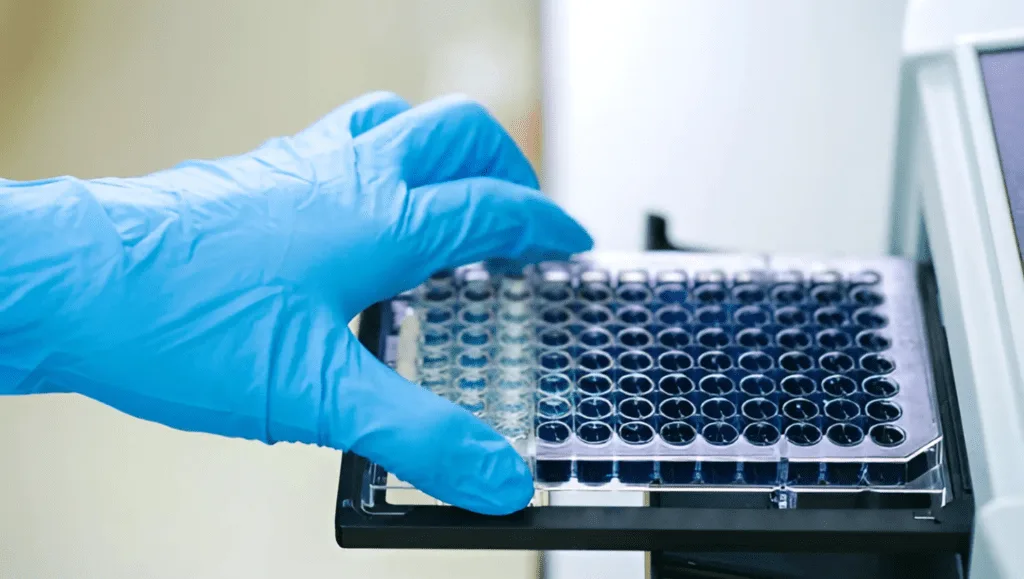Microplate readers are essential laboratory equipment used in high-throughput analysis, supporting applications like enzyme-linked immunosorbent assays (ELISA), nucleic acid quantification, and cell viability testing. Selecting the right microplate reader is crucial for achieving accurate and reliable results in research and diagnostics.
As a leading supplier of laboratory equipment in South Africa, Apex Scientific provides high-quality microplate readers from top manufacturers like Allsheng. In this guide, we’ll explore different types of microplate readers, key features to consider, and how to choose the best model for your lab.
What is a Microplate Reader?
A microplate reader is a specialized laboratory instrument designed to detect optical signals from samples in multi-well plates, commonly available in 96-well or 384-well formats. These instruments facilitate high-throughput screening by measuring absorbance, fluorescence, or luminescence, depending on the application.
Modern microplate readers offer a variety of detection modes, making them indispensable tools in biotechnology, pharmaceuticals, and clinical diagnostics.
Key Considerations When Choosing a Microplate Reader
When selecting a microplate reader, consider the following factors to ensure it aligns with your laboratory needs:
- Detection Mode: Absorbance-only vs. multi-mode
- Wavelength Selection: Filter-based vs. monochromator-based
- Application Compatibility: ELISA, fluorescence, luminescence, etc.
- Advanced Features: Temperature control, shaking function, automation
To explore available options, check our range of microplate readers.
Absorbance vs. Multi-Mode Microplate Readers
One of the first decisions when purchasing a microplate reader is whether you need an absorbance-only or a multi-mode system.
Absorbance Readers
Absorbance microplate readers measure light absorption at specific wavelengths, making them ideal for:
- ELISA assays
- Protein quantification
- Nucleic acid quantification
Multi-Mode Microplate Readers
Multi-mode microplate readers offer greater flexibility by supporting multiple detection methods, including:
- Absorbance
- Fluorescence
- Luminescence
These versatile laboratory instruments are ideal for research labs handling diverse applications, reducing the need for multiple dedicated systems.
Filter Wheel vs. Monochromator: Choosing the Right Wavelength Selection Method
Another important feature to evaluate in a microplate reader is how it selects wavelengths:
Filter Wheel-Based Microplate Readers
- Use interchangeable optical filters
- More cost-effective for routine assays
- Limited flexibility when working with varied assays
Monochromator-Based Microplate Readers
- Use diffraction gratings to select wavelengths dynamically
- More versatile for fluorescence and luminescence assays
- Higher initial cost but greater adaptability
If your laboratory conducts a broad range of assays, a monochromator-based microplate reader may be a better investment.
Understanding Wavelength Ranges in Microplate Readers
The wavelength range of a microplate reader determines the types of experiments it can support.
- Absorbance: UV-visible (200–1000 nm), ideal for ELISA and nucleic acid quantification
- Fluorescence: Requires specific excitation/emission wavelengths, used in genetic and drug discovery research
- Luminescence: Measures light emissions from reactions, commonly used in biotech and pharmaceutical research
Selecting a microplate reader that covers the required wavelength range ensures compatibility with your applications.
Common Laboratory Applications of Microplate Readers
Microplate readers support a variety of laboratory applications, including:
- ELISA – Used for antigen-antibody detection
- Cell Viability Assays – Essential for drug screening and toxicity studies
- Nucleic Acid Quantification – Measures DNA/RNA concentration
- Fluorescence-Based Assays – Applied in genetics, diagnostics, and biomolecular research
- High-Throughput Screening (HTS) – Critical in pharmaceutical and biotech research
For specialized microplate readers designed for these applications, browse our product selection.
Additional Features to Look for in a Microplate Reader
Advanced microplate readers include extra functionalities to enhance workflow efficiency:
- Temperature Control – Maintains stable conditions for heat-sensitive reactions
- Shaking Function – Ensures uniform sample mixing for better assay results
- Automated Software – Enables seamless data analysis and reporting
Selecting a microplate reader with the right features ensures compatibility with your laboratory’s workflow.
Conclusion: Choosing the Best Microplate Reader for Your Lab
Investing in the right microplate reader is essential for accurate and reproducible results. Whether you need a basic absorbance reader for ELISA assays or a multi-mode reader for fluorescence and luminescence applications, selecting the correct model is crucial for long-term efficiency.
Apex Scientific offers a variety of microplate readers from leading brands like Allsheng, ensuring high-quality solutions for research and diagnostics in South Africa.
Explore our microplate readers today to find the perfect fit for your laboratory.




